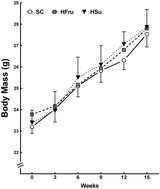Differences and similarities in hepatic lipogenesis, gluconeogenesis and oxidative imbalance in mice fed diets rich in fructose or sucrose
Abstract
Changes in feeding habits are the primary environmental factors (though modifiable) commonly correlated with increase in diseases such as obesity and associated comorbidities. Diets rich in fructose and sucrose have been related to the epidemic of obesity. Three groups of mice were studied during 15 weeks of consuming standard chow (SC), a high-fructose diet (HFru) and a high-sucrose diet (HSu). The animals did not present significant differences in food intake, energy intake, or body mass evolution at the end of the experiment. Although the findings in the HFru and HSu animals were not equal in magnitude, in comparison with the SC mice, the HFru and HSu animals showed hyperglycemia, hyperinsulinemia and hyperleptinemia as well as high levels of inflammatory adipokines, low adiponectin, and high levels of total cholesterol, triacylglycerol, and liver enzymes. The liver of HFru (more) and HSu (less) groups showed fatty infiltration and areas of necroinflammation, which are characteristic of the transition from nonalcoholic fatty liver disease to nonalcoholic steatohepatitis. In addition, the HFru and HSu groups showed increased lipogenesis, gluconeogenesis, reduced beta-oxidation and antioxidant imbalance compared with the SC animals. In conclusion, current findings demonstrate comparable adverse effects on carbohydrate metabolism, inflammatory profile, antioxidant imbalance and NAFLD in the mice of the C57BL/6 strain fed a diet rich in sucrose or rich in fructose.


 Please wait while we load your content...
Please wait while we load your content...